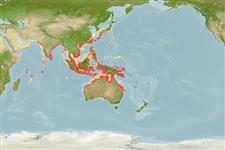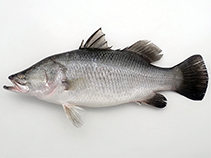Lates calcarifer (Bloch, 1790)
Barramundi
把你的觀察加入 Fish Watcher
| Native range | All suitable habitat | Point map | Year 2050 |

|
| This map was computer-generated and has not yet been reviewed. |
| Lates calcarifer AquaMaps Data sources: GBIF OBIS |
上傳你的 相片 和 影像
Pictures | Stamps, coins, misc. | Google 影像Lates calcarifer
Picture by Lai, N.-W.
Pictures | Stamps, coins, misc. | Google 影像Lates calcarifer
Picture by Lai, N.-W.
Chinese Taipei (Taiwan) country information
Common names:
[No common name]
Occurrence: native
Salinity: freshwater
Abundance: | Ref:
Importance: commercial | Ref: FAO, 2000
Aquaculture: commercial | Ref: FAO, 1997
Regulations: | Ref:
Uses: live export: yes;
Comments: Known from Tung-hsiao, western Taiwan (Ref. 43515). First successful larviculture in Taiwan occurred in 1983 (Ref. 40297). Also Ref. 47843.
National Checklist:
Country Information: https://www.cia.gov/library/publications/resources/the-world-factbook/geos/tw.html
National Fisheries Authority:
Occurrences: Occurrences Point map
Main Ref: Sukhavisidh, P. and D. Eggleston, 1974
National Database: The Fish Database of Taiwan
Occurrence: native
Salinity: freshwater
Abundance: | Ref:
Importance: commercial | Ref: FAO, 2000
Aquaculture: commercial | Ref: FAO, 1997
Regulations: | Ref:
Uses: live export: yes;
Comments: Known from Tung-hsiao, western Taiwan (Ref. 43515). First successful larviculture in Taiwan occurred in 1983 (Ref. 40297). Also Ref. 47843.
National Checklist:
Country Information: https://www.cia.gov/library/publications/resources/the-world-factbook/geos/tw.html
National Fisheries Authority:
Occurrences: Occurrences Point map
Main Ref: Sukhavisidh, P. and D. Eggleston, 1974
National Database: The Fish Database of Taiwan
Common names from other countries
分類 / Names 俗名 | 同種異名 | Catalog of Fishes(屬, 種) | ITIS | CoL | WoRMS | Cloffa
Teleostei > Carangaria/misc (Various families in series Carangaria) > Latidae (Lates perches)
Etymology: Lates: Latin, lateo, latere = to be hidden.
More on author: Bloch.
Etymology: Lates: Latin, lateo, latere = to be hidden.
More on author: Bloch.
Environment: milieu / climate zone / depth range / distribution range 生態學
海洋; 淡水; 半鹹淡水 居於水底的; 降海洄游 (Ref. 51243); 深度上下限 10 - 40 m (Ref. 7261). 熱帶; 15°C - 28°C (Ref. 2060); 49°N - 26°S, 56°E - 155°E (Ref. 54239)
分布 國家 | FAO區域 | 生態系 | 發現紀錄 | Point map | 簡介 | Faunafri
Indo-West Pacific: eastern edge of the Persian Gulf to China, Taiwan and southern Japan, southward to southern Papua New Guinea and northern Australia.
印度-西太平洋: 波斯灣到中國的東方邊緣, 台灣與日本南部, 向南至巴布亞新幾內亞南部與澳洲北部。
印度-西太平洋: 波斯灣到中國的東方邊緣, 台灣與日本南部, 向南至巴布亞新幾內亞南部與澳洲北部。
Length at first maturity / 大小 / 重量 / 年齡
Maturity: Lm 44.5, range 29 - 60 cm
Max length : 200 cm TL 雄魚/尚未辨別雌雄; (Ref. 7050); common length : 150 cm NG 雄魚/尚未辨別雌雄; (Ref. 9799); 最大體重: 60.0 kg (Ref. 28138); 最大年齡: 35 年 (Ref. 125591)
Max length : 200 cm TL 雄魚/尚未辨別雌雄; (Ref. 7050); common length : 150 cm NG 雄魚/尚未辨別雌雄; (Ref. 9799); 最大體重: 60.0 kg (Ref. 28138); 最大年齡: 35 年 (Ref. 125591)
簡短描述 檢索表 | 型態特徵 | 形態測量圖
背棘 (總數) : 7 - 9; 背的軟條 (總數) : 10 - 11; 臀棘: 3; 臀鰭軟條: 7 - 8. Body elongate; mouth large, slightly oblique, upper jaw extending behind the eye. Lower edge of preopercle serrated, with strong spine at its angle; opercle with a small spine and with a serrated flap above the origin of the lateral line. Caudal fin rounded.
細長的身體; 嘴大的﹐些微斜, 上頜延伸到眼後面。 被鋸齒狀的前鰓蓋骨的下緣, 藉由硬棘在其角上; 鰓蓋有一根小的棘而且具有一個鋸齒狀的在側線的起源上面的鰓蓋。 尾鰭圓的。
細長的身體; 嘴大的﹐些微斜, 上頜延伸到眼後面。 被鋸齒狀的前鰓蓋骨的下緣, 藉由硬棘在其角上; 鰓蓋有一根小的棘而且具有一個鋸齒狀的在側線的起源上面的鰓蓋。 尾鰭圓的。
Found in coastal waters, estuaries and lagoons, in clear to turbid water (Ref. 5259, 44894). A diadromous fish, inhabiting rivers before returning to the estuaries to spawn. A protandrous hermaphrodite (Ref. 32209). Larvae and young juveniles live in brackish temporary swamps associated with estuaries, and older juveniles inhabit the upper reaches of rivers (Ref. 6390, 44894). Have preference for cover on undercut banks, submerged logs and overhanging vegetation (Ref. 44894). Feed on fishes and crustaceans. They reach 1500-3000 g in one year in ponds under optimum conditions (Ref. 11046, 44894). Juveniles also eat insects (Ref. 44894). Sold fresh and frozen; consumed steamed, pan-fried, broiled and baked (Ref. 9987). A very popular and sought-after fish of very considerable economic importance (Ref. 9799). Presently used for aquaculture in Thailand, Indonesia and Australia (Ref. 9799). Australia's most important commercial fish and one of the most popular angling species (Ref. 44894).
在清澈至混濁的水,發現於沿岸水域,河口與潟湖了。 (參考文獻 5259) 一個河海洄游性魚, 在回到河口產卵之前居住於河。 仔魚與年幼的稚魚生活於半鹹淡的與河口相連的暫時性沼澤,而且更老稚魚棲息於河的上游。 (參考文獻 6390) 捕食魚與甲殼動物。 在最適宜的情況在一年中在池塘的範圍 1500-3000 g.(參考文獻 11046) 生鮮販賣了與冷凍的; 消費蒸, 油鍋炸的﹐火烤的與燒烤的.(參考文獻 9987) 一個非常具有經濟重要性的非常受歡迎而受喜愛魚.(參考文獻 9799) 目前用來了在泰國,印尼與澳洲的水產業。 (參考文獻 9799)
在清澈至混濁的水,發現於沿岸水域,河口與潟湖了。 (參考文獻 5259) 一個河海洄游性魚, 在回到河口產卵之前居住於河。 仔魚與年幼的稚魚生活於半鹹淡的與河口相連的暫時性沼澤,而且更老稚魚棲息於河的上游。 (參考文獻 6390) 捕食魚與甲殼動物。 在最適宜的情況在一年中在池塘的範圍 1500-3000 g.(參考文獻 11046) 生鮮販賣了與冷凍的; 消費蒸, 油鍋炸的﹐火烤的與燒烤的.(參考文獻 9987) 一個非常具有經濟重要性的非常受歡迎而受喜愛魚.(參考文獻 9799) 目前用來了在泰國,印尼與澳洲的水產業。 (參考文獻 9799)
Life cycle and mating behavior 成熟度 | 繁殖 | 產卵場 | 卵 | 孕卵數 | 仔魚
Breed in estuaries throughout the Indo-Pacific. Maturing male barramundi migrate downstream from freshwater habitats at the start of the wet (monsoon) season to spawn with resident females in estuaries (Ref. 27132) and on tidal flats outside the mouths of rivers (Ref. 6390).
Barramundi spawn on the full moon and new moon, primarily at the beginning of an incoming tide which carries the eggs into the estuary (Ref. 28135).
Barramundi are broadcast spawners that aggregate to spawn (Ref. 6390). Spawning aggregations occur in or around the mouths of rivers (Ref. 28132). While adults and juveniles are capable of living in fresh water, brackish waters are required for embryonic development (Ref. 6136). Female barramundi are capable of producing large numbers of eggs, with estimates as high as 2.3 million eggs per kg of body weight (Ref. 28134).
Barramundi are protandrous hermaphrodites, i.e., they undergo sex reversion during their life cycle. Females are generally absent in the smaller length classes, but dominate larger length classes. Most barramundi mature first as males and function as males for one or more spawning seasons before undergoing sex inversion. A few females will develop directly from immature fish (Ref. 28132). Similarly, some males may never undergo sex inversion (Ref. 28132). Also Ref. 103751.印度-西太平洋: 波斯灣到中國的東方邊緣, 台灣與日本南部, 向南至巴布亞新幾內亞南部與澳洲北部。
主要參考資料
Upload your references | 參考文獻 | 合作者 | 合作者
Larson, H., 1999. Order Perciformes. Suborder Percoidei. Centropomidae. Sea perches. p. 2429-2432. In K.E. Carpenter and V.H. Niem (eds.) FAO species identification guide for fishery purposes. The living marine resources of the Western Central Pacific. Volume 4. Bony fishes part 2 (Mugilidae to Carangidae). FAO, Rome. (Ref. 9799)
對人類具威脅
無害處的
人類使用
漁業: 高經濟性; 養殖: 商業性; 游釣魚種: 是的; 水族館: 公眾的水族館
更多資訊
Population dynamics
成長參數
Max. ages / sizes
Length-weight rel.
Length-length rel.
長度-頻率
Mass conversion
入添量
豐度
成長參數
Max. ages / sizes
Length-weight rel.
Length-length rel.
長度-頻率
Mass conversion
入添量
豐度
Anatomy
鰓區
Brain
Otolith
鰓區
Brain
Otolith
Physiology
Body composition
Nutrients
耗氧量
游泳類型
游泳速度
Visual pigments
Fish sound
Diseases & Parasites
Toxicity (LC50s)
Body composition
Nutrients
耗氧量
游泳類型
游泳速度
Visual pigments
Fish sound
Diseases & Parasites
Toxicity (LC50s)
工具
E-book | 野外調查 | 檢索表 | 長度- 頻率 Wizard | 生活- 歷史的工具 | 分布圖 | Classification Tree
| Catch-MSY |
特別的報告
下載 XML
網路資源
Alien/Invasive Species database | Aquatic Commons | BHL | Cloffa | BOLDSystems | Websites from users | 檢查 FishWatcher | CISTI | Catalog of Fishes(屬, 種) | DiscoverLife | ECOTOX | Faunafri | Fishtrace | GenBank(基因組, 核甘) | GloBI | GOBASE | | Google Books | Google Scholar | Google | IGFA World Record | MitoFish | 國家資料庫 | Otolith Atlas of Taiwan Fishes | PubMed | Reef Life Survey | Scirus | SeaLifeBase | 樹狀分類階層 | Wikipedia(去, 搜尋) | World Records Freshwater Fishing | 動物學的記錄
Estimates based on models
Preferred temperature (Ref. 115969): 25 - 29.1, mean 28.3 (based on 710 cells).
Phylogenetic diversity index (Ref. 82804): PD50 = 0.5006 [Uniqueness, from 0.5 = low to 2.0 = high].
Bayesian length-weight: a=0.00977 (0.00619 - 0.01542), b=3.00 (2.87 - 3.13), in cm Total Length, based on LWR estimates for this species & Genus-body shape (Ref. 93245).
營養階層 (Ref. 69278): 3.8 ±0.60 se; based on food items.
回復力 (Ref. 120179): 中等的, 族群倍增時間最少 1.4 - 4.4年 (K=0.09-0.13; tm=1-5; Fec = 15,300,000).
Prior r = 0.52, 95% CL = 0.34 - 0.77, Based on 3 full stock assessments.
Fishing Vulnerability (Ref. 59153): High to very high vulnerability (70 of 100).
Climate Vulnerability (Ref. 125649): High to very high vulnerability (72 of 100).




